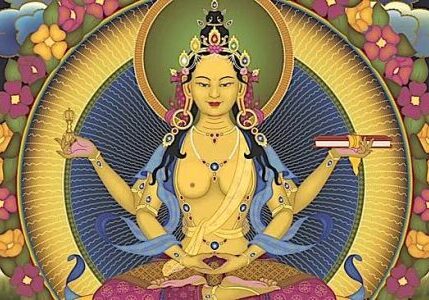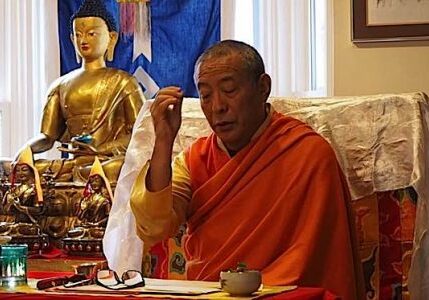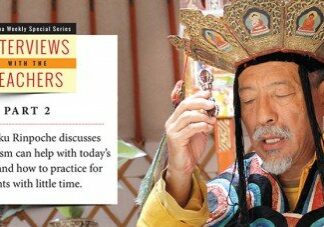Search Results: zasep tulku
Video: Students Ask the Buddhist Teacher: What advice would you give for a student who is dealing with the loss of a pet? Venerable Zasep Tulku Rinpoche
In the fourth of a new video series, Venerable Acharya Zasep Tulku Rinpoche, Spiritual Guide for Gaden for the West, answers a student’s question about loss of a pet: What advice would you give for a student who is dealing with the loss of a beloved pet? Full transcript below video. ...
Buddhist Ngondro Video 4: Overcoming the Obstacles of Irritation and Sleepy Mind –– a Foundation Practice Teaching from Venerable Acharya Zasep Tulku Rinpoche
In part four of his video teachings on Ngondro Foundation Teachings, Venerable Zasep Tulku Rinpoche discusses two of the biggest obstacles to practice and their antidotes: irritating monkey mind and sleepy mind — perhaps the biggest problems in modern practice due to the distractions of busy lifestyles. In parts one, two and three...
Video: Part 2 of Buddhist Teachings on Ngondro, the Foundation Practices with Venerable Zasep Tulku Rinpoche: Teachings on the Truth of Suffering, the Importance of Taking Refuge, and a Guided Meditation Visualizing Shakyamuni Buddha
In part 2 of a teaching series on Buddhist Foundation Practices, Venerable Acharya Zasep Rinpoche introduces the fourth outer preliminary, the truth of suffering, in the context of boundless compassion for all sentient beings. Rinpoche transitions the teachings from the outer (covered in video 1>>) to the inner preliminaries with a teaching...
La Gug Part 2 Video: Preserving Your Healthy Vitality and Life force —— from a Weekend Medicine Buddha Healing Retreat with Venerable Zasep Tulku Rinpoche
In part one of this video series on La Gug Vitality Retrieval, the most Venerable Zasep Tulku Rinpoche —spiritual head of several Buddhist Centres in Canada, the United States and Australia — explained how recognize the "symptoms your life-force is weakened." Part 1 of this video series is here: "La gug Lifeforce...
“What the Teachers Say” Video Series: Buddhist Teachings on La Gug — Restoring Life Force Vitality — from a Weekend Retreat on La Gug with Venerable Acharya Zasep Tulku Rinpoche. Part 1 — “Symptoms Your Life-force is Weakened”
La Gug literally translates as "Vitality Retrieval." For centuries, Tibetan Buddhism has perfected meditations which help you restore your vitality — also known as life force, Chi or Prana. Even modern medicine recognizes the healing power of meditation. Restoring vitality is one of the keys to good health and a long life,...
Part 3: Zasep Tulku Rinpoche discusses how to find a teacher; why its important to meditate on death; how to start with Deity Yoga; how wrathful Deities can be misunderstood; and the role of internet in Dharma teachings.
Buddha Weekly continues its special series “Interviews with the Teachers” with part 3 of an extensive hours-long interview with the most Venerable Zasep Tulku Rinpoche. Rinpoche is spiritual director of many temples, meditation centres and retreat centres in Australia, the United States and Canada and teaches also in Mexico and Mongolia. Future scheduled teachings...
Part 2 of Interview with the Teachers: Zasep Tulku Rinpoche discusses how Buddhism can help with today’s problems; on how we should think of hell realms and reincarnation; and how to practice when you have so little time.
Buddha Weekly continues its special series “Interviews with the Teachers” with part 2 of an extensive hours-long interview with the most Venerable Zasep Tulku Rinpoche. Rinpoche is spiritual director of many temples, meditation centres and retreat centres in Australia, the United States and Canada and teaches also in Mexico and Mongolia. He is also...
Buddha Weekly Special: Interviews with the Buddhist Teachers — Zasep Tulku Rinpoche
Buddha Weekly begins its special series "Interviews with the Teachers" with an extensive hours-long interview with the most Venerable Zasep Tulku Rinpoche. Rinpoche is spiritual director of many temples, meditation centres and retreat centres in Australia, the United States and Canada and teaches also in Mexico and Mongolia. He was first invited to...
Venerable Zasep Tulku Rinpoche: A big smile, easy humor, unforgettable teachings
When you first meet Venerable Archarya Zasep Tulku Rinpoche, the first thing you'll likely notice is the beaming smile. Rinpoche is remembered for his approachability—born of a combination of easy humor—and a booming laugh—together with wonderful anecdotes, inspired by a eventful life and lineage. His teachings, delivered in excellent English are easily understood and fully...















